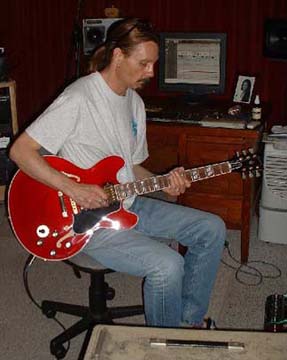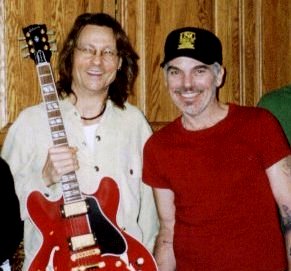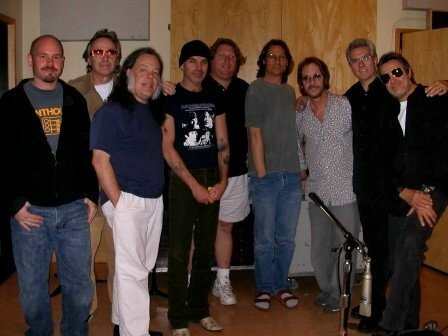Analog Dialog: Guitarist and Engineer Randy Mitchell
 |
|
Randy Mitchell
|
Randy Mitchell is a guitarist first, engineer second. He has spent two decades as a touring and studio musician in L.A. His dad bought him an Ampex two-track when he was a teenager and Randy started recording band rehearsals and other casual gigs. When he was 20 years old, he was touring with the Boone family (Pat and Debbie), which was to be the springboard for a successful career as a professional guitarist.
So how did you end up doing the engineering for The Edge of the World?
“It’s really been an ongoing process, having my own studio of sorts for years and [which] finally evolved into getting a Pro Tools rig. I came on board as a guitar player with Billy Bob. We did the recording on Radar in Billy Bob’s home studio, “The Cave” and when it came time to do some edits, Jimmy Mitchell (no relation) the producer asked me to do the editing on Pro Tools. So I ended up doing a lot of the editing and then there was a lot of recording that needed to be done in addition to what was already there, overdubs and such. I ended up engineering vocals, acoustic guitars, electric guitars and some keyboards—whatever else was needed to finish up the record.”
 |
|
Randy and Billy Bob
|
“I own a 2-610 and a LA-2A and a lot of the acoustic guitars were done in my studio using the 2-610, then the LA-2A to Pro Tools. For me, tube mic pres have a sound that translates into an upper high-end sheen that solid-state components don’t get. It adds an upper brilliance to the acoustic guitar. The 2-610 just has this unique and classic character that nothing else has and Billy’s all about that for sure. Having the two shelving EQ knobs on there was helpful when I was listening to something like an acoustic guitar and I was tracking and needed to roll off or add a certain frequency. Most of the guitars went through the LA-2A. It’s the golden box; use it, and everything just comes out perfect.”
“When we went to mix over at Billy’s, he had a vintage 1176 and a new UA 1176. We used those and I brought my new LA-2A over and they rented a couple of vintage LA-2As. Jim and I compared all of them and they all sounded slightly different. The thing noticed was that the old ones had a little hair, a certain cloud about them and we didn’t know if it was maybe that the tubes were older but it was minor. The advantage of the new LA-2A is that it was noticeably quieter and it was a bit faster too, which we kind of liked. The LA-2A was used on the entire mix.”
Billy Bob Thornton’s record The Edge of the World received much acclaim and Randy went on to accompany Thornton on a sold out tour throughout the US. A lot of magic moments there…but there’s another story he told me that I just have to share.
“Warren Zevon and Billy Bob are old friends. They were neighbors years ago. When Billy was working on his record, Warren was at this time very sick and weak from lung cancer and Billy asked him to just come hang out in the studio while they were recording and maybe sing on his record. At the same time Warren was working on what would be his last record. (The Wind, which Zevon started when he found out he was dying.) One night at Billy’s studio, we had Steve Gorman on drums, Tommy Shaw on guitar, Brad Davis on acoustic and Jorge Calderon, Warren’s bass player and producer. I was on slide, with John Waite singing background, Warren was playing organ. We were listening back to a song we were working on for Billy’s record and there was a lull in the conversation. Suddenly Warren said ‘Wouldn’t it be funny if for my last record I did Knockin’ on Heaven’s Door?’ Everybody was really quiet and it was kind of uncomfortable and Billy said. ‘Let’s do it!’”
“That was it. We didn’t even run it down first, Warren just got on the microphone and we went. We stopped and said, ‘Gosh that sounded good. Let’s do it again.’ We did it one more time the same way and I think the second one was the one they kept. Originally I think my parts were going to be gone over by either David Lindley or Ry Cooder and I thought that’s how it should be—those guys are spectacular—but a few months later, Jorge told me that they decided to leave my parts on as it was, and they didn’t edit any of it. [Recording my part for Warren’s song] was an experience I’ll never forget, it was magical and deeply sad all at the same time.”
 |
|
Warren Zevon among good friends
|
It was a very courageous way to face death and ultimately reminds us of the power of music and why we are in this crazy business. Randy told me “I love it all, touring, recording, playing. I’m so lucky to have this life.
Thanks to Randy for sharing this story.
Interview by Marsha Vdovin
Questions or comments on this article?